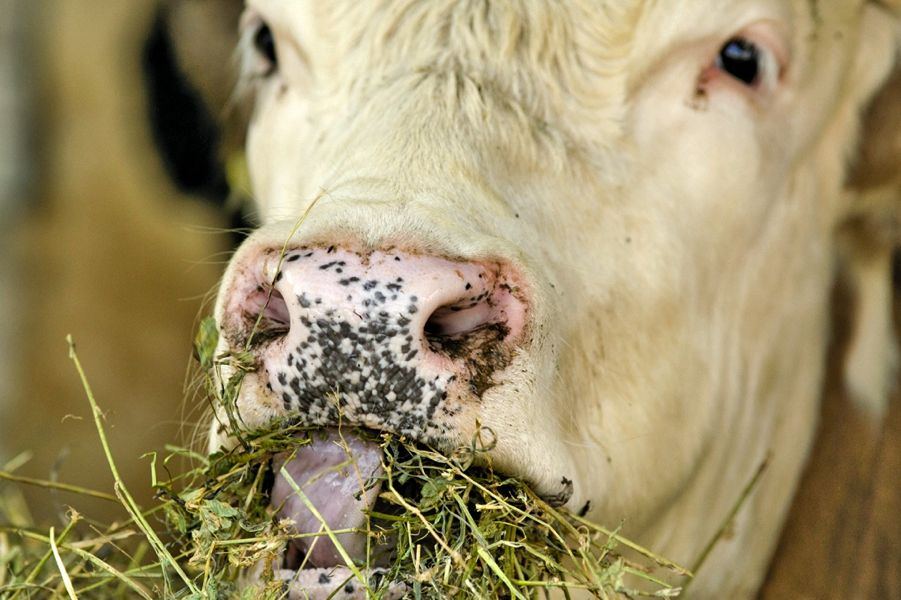Shown only as a "what if". You cannot feed on a dry matter basis. Moisture is real, it exists and is part of the ration.
Mistakes in converting from “as fed” to “DM” or vice versa when feeding cattle can be costly and as such I would like to start out the New Year with a column that focuses on the importance of understanding this conversion.

www.canadiancattlemen.ca
When I visit with beef producers about their feeding program, I often sense confusion when I talk feed dry matter (DM) values or express intakes on a DM basis. Most producers, when they think of their feeding program, think "as fed" and have difficulty converting to DM. Getting this conversion correct, however, is critical to understanding not only if you are providing the right amount of feed to your cattle, but also influences the daily intake of essential nutrients. Mistakes in converting from "as fed" to "DM" or vice versa can be costly and as such I would like to start out the New Year with a column that focuses on the importance of understanding this conversion.
Perhaps the best example to illustrate the importance of this conversion is with cereal silage. Typical corn or barley silage harvested at the correct stage of maturity will have 35 per cent DM and 65 per cent moisture. What this implies is that one pound of silage has 0.35 of a pound of DM; the rest is moisture. It is also important to note that the nutrients are associated with the DM not the moisture. As a producer who is used to feeding hay, you might feel that 30 pounds of silage is more than enough to fill up a 1,300-pound cow. However, because of the moisture in the silage, that animal is only receiving (30 x 0.35) 10.5 pounds of DM. In contrast, feeding 30 pounds of hay at 87 per cent DM equates to 26 pounds of DM. If you only feed 30 pounds of silage, you have one hungry cow!
This example also highlights the importance of understanding how you express the nutrient content of your feed. As a diligent reader of this column, you had a feed test on your silage and noted that it came back on an "as fed" basis at four per cent crude protein and 22 per cent total digestible nutrients (TDN). At first glance, your impression is that this silage is extremely poor with respect to quality. However, when expressed on a DM basis, which can be done by dividing the "as fed" nutrient value by the DM content (i.e. four per cent crude protein/0.35), the protein content is 11 per cent and the TDN is 63 per cent, a much higher-quality feed. A similar calculation applies to the value of the silage. In the pit, the silage might be worth $60 per tonne; however, on a dry matter basis, it is worth ($60/0.35) $171 per tonne.
Feed consumption can also be expressed on an "as fed" or "dry matter" basis. Grain- and/or hay-based diets are typically 85 to 88 per cent DM, while addition of silage to the ration reduces DM content to the point where straight silage is typically 35 per cent DM as discussed above. Nutritionists express an animal's requirement for specific nutrients as absolute amounts per day (i.e. pounds of TDN or protein, Mcal of net energy) or as a proportion of the diet DM (i.e. TDN per cent, CP per cent, Mcal/kg NE). In either case, you need to know how much DM an animal consumes in order to put the right combination of feeds together that matches its nutrient needs. By so doing, when we compare feeds or feeding programs, we compare "apples to apples."
The amount of feed an animal consumes varies with age, weight, level of production (i.e. pregnancy, lactation, growth) and environment. It will also vary with the amount of moisture in the feed and the quality of the feed. Consider a 1,300-pound beef cow. Typically, this animal would be expected to consume two per cent of her body weight on a DM basis or 26 pounds of DM daily. This equates to 30 pounds of hay at 87 per cent DM, or 74 pounds of silage at 35 per cent DM. However, as discussed above, feed quality has a great influence. Poor-quality forages such as straw or slough hay will be consumed at much lower levels (i.e. 1.25 to 1.5 per cent of body weight, DM basis), while with higher-quality forages such as alfalfa or alfalfa grass hay, DM intakes will approach 2.5 per cent of body weight. In the case of feeding the poor-quality forage, it will be essential to provide supplemental feed to ensure optimal nutrition while with the alfalfa hay, you may actually have to restrict intake to prevent your cows from becoming over-conditioned.
With feeder cattle, it is common to find DM intake expressed as either "pounds of feed DM per day" or "DM intake as a per cent of body weight." For example, calves that are healthy and eating well typically have a DM intake that equates to 2.5 per cent of their body weight. A 650-pound calf at 2.5 per cent of body weight consumes (650 x 0.025) 16 pounds of DM. If the diet is 70 per cent dry matter, then the "as fed" intake is (16/0.7) 23 pounds per head per day. However, as time on feed increases and as the calf gains weight, DM intake expressed as a percent of body weight declines to the point where cattle are eating at a level less than two per cent of their body weight. Actual pounds of DM consumed, however, increases as the animal gains weight throughout most of the feeding period.
The take-home message is understanding feed DM intake is key to understanding cattle nutrition; all it takes is a little math and practice.
Contributor

